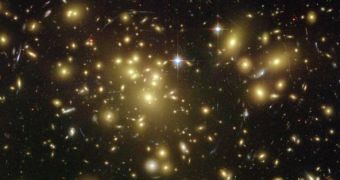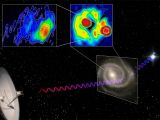According to a new study carried out at the Max Planck Institute for Radio Astronomy, the mass ratio between the electron and the proton remained constant over the past 6 billion years. This comes to contradict the findings of a study conducted nearly two years ago which suggested that the masses of the two particles varied significantly since the Big Bang event which is responsible for the birth of the universe.
There are some theories in physics implying that certain physical constants of the universe might have varied in time, including the masses of sub-atomic elementary particles. Finding out whether this is true or not may have significant implications on our understanding of the universe, its nature, if the speed of light varied as well or whether mysterious entities such as dark energy and extra hidden dimensions can exist.
"Some theorists claim the physical constants should have varied over time. This is something that is part of the modeling of the universe," said Christian Henkel of the Max Planck Institute for Radio Astronomy. According to the measurements made by the Max Planck Institute team the mass ratio of the two particles would have varied in the last 6 billion years by less than 2 parts per million, too little to show a significant change in mass between the two, which suggests that these physical constants didn't vary at all.
It all started when the team identified ammonia in a galaxy some 6 billion light years away by observing light emissions coming from a background quasar. "Ammonia is a molecule with a very special structure," Henkel explained. It has a pyramidal structure with three hydrogen atoms at the base and a nitrogen one on top of them.
What is really special about ammonia is that when it is energized by radio waves, the nitrogen atom moves to the other side of the plane formed by the hydrogen atoms, which as it turns out also depends on the mass ratio between the proton and the electron. By comparing ammonia absorption in the studied galaxy with the available data, the team found that the electron is 1,836 times less massive than the proton, about the same ratio as the one between the masses of electrons and protons here on Earth.
"It is a puzzling result, but I am sure they did a thorough job," said Wim Ubachs of Vrije University, who, back in 2006, showed that about 11.5 billion years ago the mass ratio between the two particles varied by as much as 20 parts per million. Apparently, the two studies contradict each other, although the truth is that they don't, since they involved observations in different time periods in the evolution of the universe.
This implies that the physical constants of the universe stopped varying about 6 billion years ago when dark energy started accelerating the expansion of the universe. It could also be evidence of the presence of extra spatial dimensions, albeit until the data is thoroughly analyzed nobody can say for certain if or what causes this effect.
"We hope that the upcoming results will shed more light on the issue, which is very intriguing indeed," Ubachs said.

 14 DAY TRIAL //
14 DAY TRIAL // 
